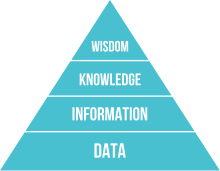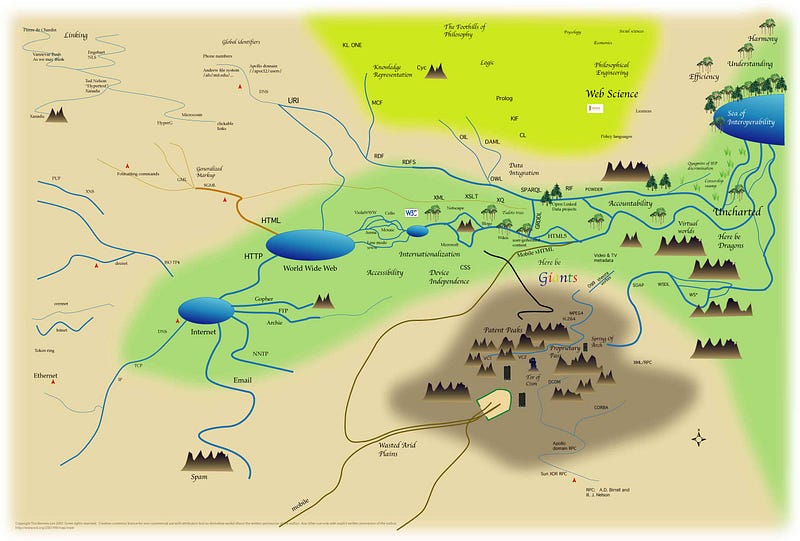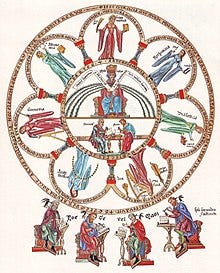Knowledge Age - A conceptual evolution of the Cyber-Physical from our Present Information Age
Introduction

DIKQ Pyramid: Data, Information, Knowledge, Wisdom
The Knowledge Age is foreseen as a possible evolutionary integer that may evolve our present ‘information age’ to one that improves sense making for natural actors otherwise poorly supported by the tooling for our present information age.
The theoretical consideration is that; After an uprising, due to the socioeconomic harms caused by bad actors; exploiting the natural world and all living beings subjected to the acts of non-living legal persons run by humans and increasingly also AI for greed in the information age; the approach to informatics systems will change to support knowledge engineering principles.
The Naturally Deterministic rationale
As the centralisation to a level of despotism, irrecoverably undermined capacities to sustainably develop the 4th industrial revolution, built upon global economic foundations that are morally consistent and inclusive to fake news, the oligarchy become know instruments of harm to our planet and the vast majority of life on it.
The Knowledge Age emerges as Decentralised Information Systems reunites the personhood of natural persons with an ability for them to build trusted informatics peers; in an infosphere of inforgs, through the use of machine and human readable data-structures producing what is considered to be a “human centric” web or info-sphere.
Amongst the many very significant changes, it is expected that work conditions for knowledge workers will improve radically.
Distinction to the Information Age
The Information Age is now rapidly bringing to bare the means for a few to curate information that is stored in electronic formats, as humanity and our natural world is consumed through the use of a globally networked “Cyber” environment.
These systems do not meaningfully, however, retain means to ensure natural persons retained any beneficial rights and/or interests, over the data produced, stored and employed by legal personalities in relation to them.
These informatically designed & orchestrated works of art threaten our planet and poorly interferes with our means to care for all life, in it.
The information age now in-turn presents the world, in a commonly understood manner, a lack of valued merit to discern or make distinct information that may be false (such as fake news) and knowledge, as should be relied upon as an underlying and instrumental ingredient; required for any pursuit in any field of STEM by natural agents working on STEAM.
The Knowledge Age is founded upon differentiated ‘systems thinking’ that puts at the centre of all curated considerations; the effects cyber-physical systems have upon mankind and through our lens, our broader biosphere.
Web Science: The underpinnings of shared philosophical theory
Since the start of the development of the world-wide-web project as was brought about by Tim Berners-Lee through his works in cern, an emergent ‘interference pattern’ has enveloped the world. The effect of these patterns now leads to international discourse in the united states about the concept of an information fiduciary; whilst others grapple with the consequential inter-agent relations as our most instrumental international agreements, such as those forged by way of the United Nations; including but not exclusive to, the UDHR and the Convention of the Rights of the Child which is known to be knowingly breached. Whilst our means of employing this infrastructure in the information age provides few good options, to do much about it at all.
The knowledge age in-turn supports sense making for this as one of many pressing examples, that brings into question, the relevance and useful benefits of morality.
Whilst the information age illustrates so many critical issues that deserve our attention; it is the proposition of a knowledge age that best provides mankind the ability to do something about it.
In This video, Noam Chomsky describes his concept of moral grammar
“Hume wrote about this, he put it in different terms than we would use. Humans have the capacity to make moral judgements in new situations, in ways that conforms to the understanding of others. (and he says) The only way this is possible, is if there are principles that are part of our nature… he says, these are different to the instincts that are shared with other animals. So we have some form of instincts that are an original part of our nature and these somehow yield judgements that are comprehensible to others, and often accepted by others…. and if we reach different judgements, we don’t just need to throw stones at each other, we can have a kind of moral discourse about it, try to find common-ground and see where we can go to from there… these are just human capacities…”
Therein, the concept of Web Science develops upon a primitive basis of consideration that as a species we innately have some sense of ‘moral grammar’; and now therefore, given the underlying series of innate qualities, exists in the natural world; in relation to our status of consciousness, as natural persons process in the form of ‘sense making’, issues, the knowledge of how our information systems fail to provide appropriate accommodations, as to render reliable knowledge frameworks is brought about as to engender the shift.

W3C: map as described elsewhere by Tim Berners-Lee
The information age embodies problems; that are considered at this stage, to be anecdotally addressable, in the realm of philosophical engineering, rather than as may be address socioeconomically as an underlying STEM challenge, requiring radically different approaches to the delivery of technology.
Therein the underlying concept of binding information science with philosophical engineering as to produce a capacity for humans to work cooperatively in this emergent field of web science was depicted by a map image produced by Tim Berners-Lee in 2007.

Tim Berners-Lee and an array of others in the world have been cooperatively collaborating on an informatics tooling framework built upon the concept of a semantic web. This has evolved over many years; and is interoperable with the broader liberal arts education related fields of expertise. When applied to the production of code, that is made to be consumable by software agents (AI); the introducing a new class of actor referred to as social machines intersect the intentional design frameworks and the means through which they are employed, using Web Science.
Whilst many now debate what is in the interests of engineering knowledge based systems; distinct design paradigms in a knowledge age, would provide alternative corpus modalities; by incorporating natural agents into equations.
OBJECTIVE: Building the Reality-Machine
The objective of the Knowledge age is to support the means to distinguish facts from fiction. Over known history. The ability to make distinct information which is in-fact false, faceted, or subject to an interpretable nuances which cause interference patterns, is known to disrupt sense making.
Whether it be in relation to the status of the observer or any other reasons; the field of informatics sciences have been subjected to evolving challenges.
In the 20th century our means to use western methods to communicate developed exponentially.
In the 21st century the leaders of the world; in industry and elsewhere, started to make intentional choices to spread fake news and false representations for economic benefits; as designed to engender others to act on a basis of this false information for some intended or unintended purpose.
Whilst these forms of behaviour is ancient in its heritage, the simultaneous undertaking made; was to form a global graph of pervasive surveillance that could be consumed by vast energy consuming capabilities owned and operated by various persona ficta world-wide in pursuit of economic gains.
These technologically empowered cyber-physical activities; brought with it, the means to link every computer in the world together, as to have them act using software in a programmatically defined framework to deliver outcomes.
This capability, in our information age, is now in-turn employed to facilitate means that seek human participation as to consume; both our attention by way of an attention economy, selling advertising and to get data produced by our existence for commercial use that may later be put upon us, by the few.
The problem brought about; is that whilst our ICT systems, are now capable of networking enormous amounts of information sourced from across the world…
As is used in web search engine solutions such as google to present information sourced world-wide in seconds,
These systems suffer from a wide-spread inability to deliver reliable knowledge about important issues affecting humanity.
The objective of the Knowledge Age is then in-turn about the shared purpose of all ‘good thinkers’, living, in reality; to build a ‘reality machine’, that employs the same ICT infrastructure already in place, whilst repurposed to deliver knowledge resources that are consistent with reality; rather than the alternatives provided worldwide, for economic gains in the early 21st century.
Techno Social Background
Whilst the manifest reality of how the knowledge age comes about is yet to come of age; some insights can be engendered by studying the heritage of information technology and some of the key events considered to bring about the now destabilising forces, that are expected to result in the billions of Homo sapiens (Latin: “wise man”) collectively migrating to employ ‘knowledge economy’ ICT tools; that incorporate attitudes of furnishing value to the natural actor in a manner distinct to alternatives.
A distinction between systems that furnish knowledge based equity exclusively to legal personalities; and more particularly also, to foreign jurisdictions from the perspective of those who form part of the habitat relating to the geographical location of natural actor;
as does engender a status of legal alien in relation to the data subject;
A knowledge age would consider the point that those who produce, support and render nuanced informatics schemes, considered to interactively supply & support ‘human centric’ informatics systems. As humanity are the key constituent entities of the most critical characteristically distinct informatics models; used to define what and how systems are designed, for purposes more eloquent than merely the supply of information, a knowledge age would consider what has been engineered for knowledge, and how it is supplied..
History of our Information Age as to deliver a Knowledge outcomes.
In the July 1945 issue of The Atlantic, the article by Vannevar Bush “As We May Think” considered
“Consider a future device … in which an individual stores all his books, records, and communications, and which is mechanized so that it may be consulted with exceeding speed and flexibility. It is an enlarged intimate supplement to his memory.”
As Director of the Office of Scientific Research and Development, Dr. Vannevar Bush has coordinated the activities of some six thousand leading American scientists in the application of science to warfare. In this significant article he holds up an incentive for scientists when the fighting has ceased. He urges that men of science should then turn to the massive task of making more accessible our bewildering store of knowledge. For years inventions have extended man’s physical powers rather than the powers of his mind.”[4]
This record was later a constituent of the remarks made by Ted Nelson in 1965 as he recorded and presented his views on A File Structure for The Complex, The Changing and the Indeterminate, In which he declares, his (creative) works, and went on to declare a conceptual frameworks in which he presented his ideas of a Evolutionary File Structure (ELF), as a form of electronic list packaging framework for documents.
His design extended by way of a “Personalized Retrieval, Indexing, and Documentation Evolutionary” System (PRIDE).
At this time Ted Nelson, perhaps more importantly, Nelson went about defining a method in which to produce a system for the storage of knowledge on computing systems and in so doing, defined the terms HyperText and HyperMedia introducing the word “hypertext” as a be defined method to address the the problem he described in the following way;
“a body of written or pictorial material interconnected in such a complex way that it could not conveniently be presented or represented on paper. It may contain summaries, or maps of its contents and their interrelations; it may contain annotations, additions and footnotes from scholars who have examined it. Let me suggest that such an object and system, properly designed and administered, could have great potential for education, increasing the student’s range of choices, his sense of freedom, his motivation, and his intellectual grasp”.
Thereafter Robert Elliot Kahn & Vinton Gray Cerf produced Internet Protocol, Sir Tim Berners-Lee produced WWW which shortly thereafter, involving amongst others, James Hendler DAML, the Semantic Web and overtime the array of URI based machine-readable solutions that brought about an age where everything became interconnected.
This in-turn brought about an emergence of alternative decentralised database technologies such as BitCoin and other DLT solutions in addition to an array of other alternative protocol stacks that made attempts to solve Web science problems unable to be solved via the well forged Internet governance modalities which are in-turn being rendered support by way of DIDs (as distinct to dissociative disorder) which make an attempt to unify the graph database capabilities that produce the knowledge graphs used by Oligarchy; whilst providing hope,
For others; that solutions may emerge, as to forge a knowledge Infosphere fit for purpose as a Prosthesis for human consciousness. In more recent ideas published online, this is better considered; as a format for your digital twin.